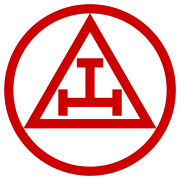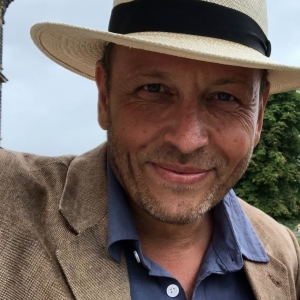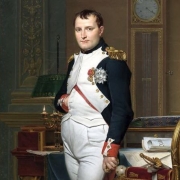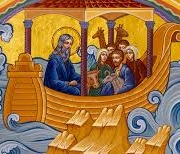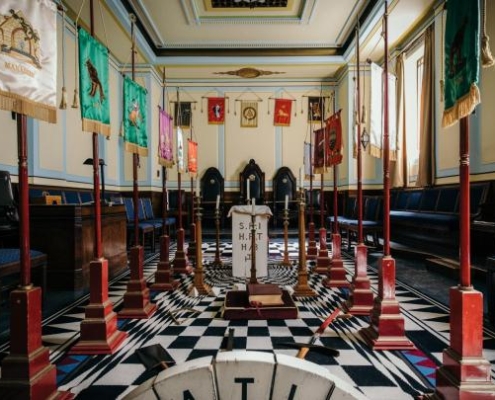
As with Blue Degrees, the Royal Arch conveys moral and ethical lessons. In the three Degrees of Craft, the candidate is taught a series of practical principles of service to his fellow man. But since man is not only a practical being, he also has an essential spiritual aspect to his nature. The Royal Arch further develops this latter aspect through a consideration of the spiritual nature of man, not in substitution but in support of what the candidate has learned from his own religion. In the chapter, the teachings of the Royal Arch are conveyed through a ritualised allegory based on the Old Testament stories of the return to Jerusalem from the Babylonian exile to rebuild the city and the temple. In clearing the ground of Solomon's Temple for the foundations of a new temple, the candidate makes important discoveries. By adding a further explanation to the practical lessons of Craft Freemasonry, the Royal Arch is seen as an extension of the previous degrees and the philosophical lessons conveyed are appropriate to that stage in a candidate's Masonic development. The symbol or grand emblem of Royal Arch Freemasonry is the Triple Tau.
In the British Isles, most of continental Europe and most Commonwealth countries (with the notable exception of Canada), the tenets of Royal Arch Freemasonry are contained in the Supreme Order of the Holy Royal Arch - a self-contained degree of Freemasonry open to those who have completed the three Blue Degrees. Until 1823, only Freemasons who had previously held the chair of a Blue Lodge were allowed to take part. Nowadays, candidates for an English Holy Royal Arch Chapter must have been a Master Mason for four weeks or more. In Freemasonry in Scotland, the candidate for the Royal Arch must also be a Mark Master Mason, a degree that is part of the York Rite. It can be done in a Chapter, or more often it is done in a Scottish Lodge. After the Mark degree, a candidate must complete the Excellent Master degree before being elevated to the Royal Arch degree. In Ireland, a candidate must complete one year of Master Masonry before being admitted as a member of a Royal Arch Chapter. The Mark Master Mason degree is first obtained separately and only then can the Royal Arch Degree be obtained.
In the United States, Canada, Brazil, Israel, Mexico, Paraguay and the Philippines, the Royal Arch is not used as a separate degree, as described above, but is part of the York Rite system of additional Masonic degrees. Royal Arch Masons in the York Rite also come together as a Chapter, but the Royal Arch Chapter of the York Rite has four different degrees: 'Mark Master Mason', 'Virtual Past Master', 'Most Excellent Master' and 'Royal Arch Mason'. Although the York Rite degree of 'Royal Arch Mason' is roughly comparable to the Supreme Order of the Holy Royal Arch as practised in England and Wales, the other degrees may have equivalents in other related orders. The Royal Arch is also the subject of the 13th and 14th degrees of the Scottish Rite of Freemasonry (called "Old and Accepted Rite" in England and Wales).
History.
At the beginning of the 18th century, there were only two Blue Degrees. The degrees and rituals, as we know them now, did not exist. The two ceremonies were very short and consisted of a recitation of the old legendary history of Freemasonry, an obligation and an assignment, together with the entrustment of a grip accompanied by a word. The Festive Board was followed by a form of catechism among the Brethren. This procedure was gradually extended and finally, around 1724/25, a Third Degree appeared. By 1730 the Third Degree was fairly widely known, though not extensively practised. At this stage, all three working ranks within the Blue Degrees were covered by separate ceremonies. However, there was still no awarding ceremony for men who had presided over a Lodge as Honorable Master.
Three theories are currently postulated. The least likely is the suggestion that the Royal Arch was once part of the Third Degree ceremony, which was then mutilated to produce a Fourth Degree. Some believe that the Third Degree and the Royal Arch had a common origin; a view supported by the fact that what is lost in the Blue Degrees is found in the Royal Arch ceremony.
Others believe that the Royal Arch was imported from Europe and quickly found favour with English freemasonry. There is no doubt that something was emerging in the early 18th century that later became the Royal Arch, although the form and content of its development will probably remain veiled in the mists of time.
If the European theory is correct, it is likely that the ceremony originated in France, where a large number of Masonic innovations and degrees were introduced in the early 1740s. There is an interesting reference in the "Sceau Rompu", a 1745 exhibition, to a superior class of Freemasons with a ceremony designed to commemorate those who worked "... with the trowel in their hand and the sword at their side". Several similar pieces of evidence support the view that certain characteristic features of the Royal Arch ceremony, by whatever name it was known at the time, existed on the continent at an earlier date, but this cannot be taken as proof of origin.
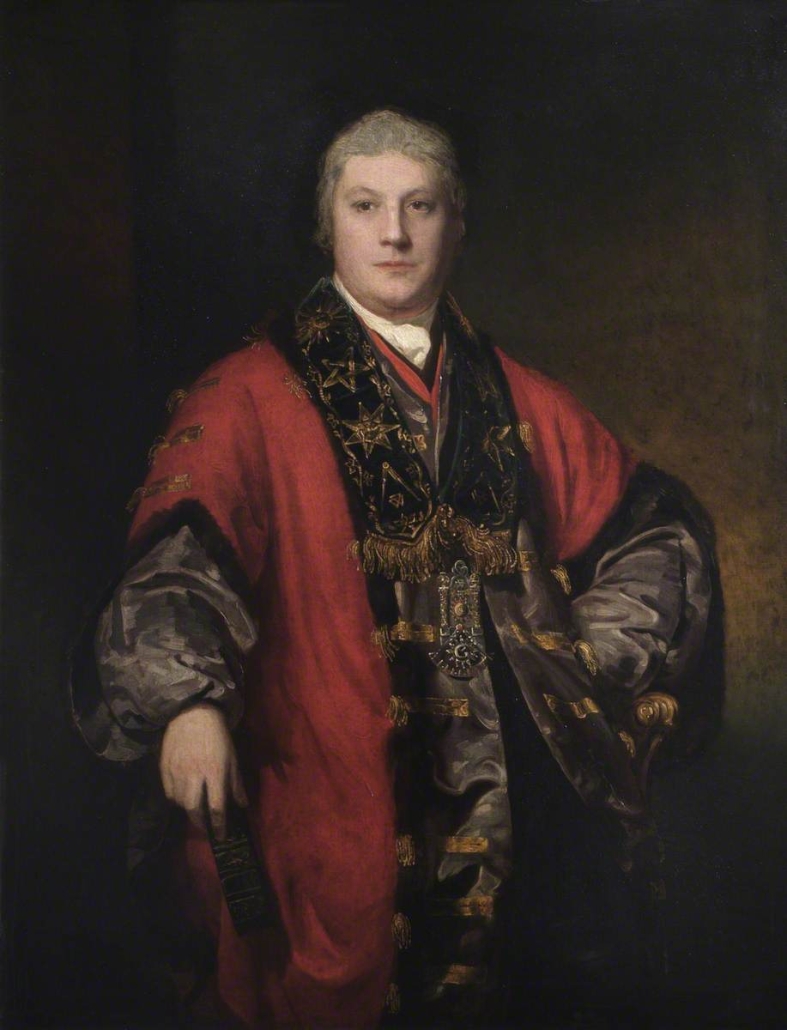
King Henry Frederick (1745-1790), first Duke of Cumberland and Strathearn with the regalia of the Holy Royal Arch.
The first documented evidence of the Royal Arch as a separate degree comes from the minutes of Lodge No. 21 in Youghal, County Cork in 1741. However, the oldest known Chapter in the world is Stirling Rock Royal Arch Chapter No. 2 in Scotland, which has operated since 1743. Laurence Dermott's "Ahiman Rezon" states that the degree was worked in London from at least 1744. This assertion is supported by a book entitled "A Serious and Impartial Inquiry into the Cause of the present decay of Freemasonry in the Kingdom of Ireland" ", by Fifield Dassigny MD published in Dublin in 1744, which states that the Degree was at that time worked in London and York. In 1749 the Grand Lodge of Ireland issued orders to Lodges 190 and 198 to establish "Royal Arch Lodges". The degree is also censured in Dassigny's "A Serious and Impartial Inquiry into the Cause of the Present Decay of Freemasonry in the Kingdom of Ireland", published in Dublin in 1744. Separate notes in this work indicate that the rite was practised in Dublin, London and York, and described it as an "organised body of men who have passed the chair" (i.e. who had presided over a Blue Degrees Lodge as Honorable Master).
The ties between the royal family and the Royal Arch in England began in 1772, when HRH Henry Frederick, Duke of Cumberland (brother of King George III) became a member. In 1774, he was elected Grand Patron of the Royal Arch - a portrait of him in his robes for that office still hangs in the Masonic Hall. In 1776 he was elected First Grand Principal and held that position until 1785. On his death in 1790, he was succeeded as Grand Patron by his nephew HRH William, Duke of Clarence (later HRH King William IV).
England and Wales "Antients" versus "Moderns
In 18th century England, the role and purpose of Royal Arch Freemasonry was the subject of a long debate between the two rival umbrella organisations of Freemasonry. In 1717, four Blue Degrees lodges had formed the original Premier Grand Lodge of England to govern Freemasonry as practised in England. From 1751, this claim was disputed by another group of Blue Degrees Lodges who formed the Antient Grand Lodge of England. In the ensuing debate, the newer Grand Lodge was briefly known as the "Antients", while the older Grand Lodge was called the "Moderns".
In 1746 Laurence Dermott, who would later become Grand Secretary of the Antients, was admitted to a Royal Arch Chapter in Dublin, which at that time was only open to those who had previously served as Masters of a Blue Degree lodge. He regarded the Royal Arch as the fourth degree of the traditional Blue Degrees. Under his influence, the "Antients" defended the Royal Arch degree in England, while it was received with hostility in the Premier Grand Lodge of England.
In 1764 a Lodge of Scottish Freemasons attached to the "Antients" changed sides and became the Caledonian Lodge attached to the "Moderns". The following year they helped to establish a Royal Arch Chapter which admitted Freemasons from other Blue Degrees lodges attached to the Moderns. In 1766, with the elevation of Lord Blayney, the Grand Master of the Moderns, this organisation became known as the Excellent Grand and Royal Arch Chpater, taking on administrative responsibilities and thus becoming the first Grand Chapter in England. At the same time, James Heseltine, the Grand Secretary of the Moderns, stated about Royal Arch Freemasonry that "it is part of Freemasonry but has no connection with Grand Lodge" in a letter to a senior German Freemason. He was also one of the signatories of the charter establishing the first Grand Chapter. The minutes of the first meeting of Grand Chapter show that it met at the Turks Head, in the London district of Soho, the same tavern where, shortly before, the birth of the Antient Grand Lodge of England had been held. On this occasion, Thomas Dunckerley was elected to hold the office of Z (chief officer of the chapter) in the absence of the Grand Master and Deputy Grand Master. He was later appointed Grand Superintendent and promoted Royal Arch Freemasonry in the provincial lodges of the "Moderns" with great energy and success. In 1774 the "Antients" formed their own Royal Arch Grand Chapter at the instigation of Laurence Dermott. The members were officers of the Grand Lodge who happened to have the Royal Arch degree, the meetings were ordered by the Grand Lodge and the proceedings approved by the same body.
Uniting the two Grand Lodges
At the beginning of the 19th century, as the 'Antients' and the 'Moderns' moved from rivalry to union, the role and purpose of the Royal Arch became a sticking point. The "Antients" regarded the Royal Arch as a fourth degree of traditional Freemasonry and worked it as part of the rituals of Blue Lodges, while the "Moderns" ignored it almost entirely. They believed that Freemasonry consisted of only three degrees and that the Royal Arch was at best an extension of the third, Master Mason degree that had to be administered separately. Moreover, the "Moderns" embedded certain teachings in their third degree ritual that the "Anten" revealed only to those who joined the Royal Arch.
In 1813, the "Antients" and "Moderns" agreed on an Act of Union and formed the United Grand Lodge of England. This was only possible after reaching a compromise on the role and purpose of Royal Arch Freemasonry. The compromise was that after the union, the Royal Arch degree would be fully recognised by the United Grand Lodge (to appease the "Antients"), but would become a separate order (to appease the "Moderns"), while all Blue Degree Lodges would be given sanction to work the ceremony (to appease the "Antients"). At the same time, no compromise could be reached on the role and purpose of the Mark degree. It was effectively banned by the Union until the 1850s, when it was organised into an independent Grand Lodge of Mark Master Masons of England and Wales. In most countries outside England and Wales, however, Mark Freemasonry became associated with Royal Arch branches. In its Book of Constitutions, the United Grand Lodge of England therefore declared that "... pure Antient Freemasonry consists of three degrees and no more, namely those of the Apprentice, the Companion and the Master Mason including the Supreme Order of the Royal Arch.".
In 1817, four years after the "Antients" and "Moderns" had united their Blue Degrees Grand Lodges, the new United Grand Lodge oversaw the formation of a "Supreme Grand Chapter of Royal Arch Masons of England" to govern the Holy Royal Arch in England and Wales. By this time the Grand Chapter of the "Antients" had effectively ceased to exist (only a few meetings are recorded for the time after 1813), so their remaining members were simply absorbed into what had previously been the Grand Chapter of the "Moderns. ".
Another important constitutional development in Royal Arch Freemasonry took place in 1823, when Master Freemasons were allowed to join the Holy Royal Arch Chapters without having previously passed through the chair of a Blue Degree Lodge.
In 1835 the ritual was reformed, when part of the ceremony known as "Passing the Veils" was dropped. It was re-adopted by Bristol Chapters at the beginning of the 20th century.
Development since reunification.
The "Antients" Grand Lodge, which seceded in 1751, received Royal Arch Freemasonry with great enthusiasm. Laurence Dermott, the second Grand Secretary, described the Royal Arch as "... the root, the heart and the marrow of Freemasonry". It was openly granted as a Fourth Degree in its Lodges with the consent and approval of the "Antients", who became known as the "Grand Lodge of the Four Degrees". Indeed, their first set of Rules and Regulations states that "Ancient Freemasonry consists of four degrees - the apprentice, the fellow Craft and the sublime degree of Master" and goes on to provide that "... a brother who is well versed in these degrees and has been discharged the offices of his lodge, especially those of Master, shall be eligible to be admitted to the fourth degree, the Royal Arch". The Rules also state that "Each Regular Lodge shall possess the power to form and hold Lodges in each of its several Degrees, the last of which, of its superiority, shall be designated among Masons, a Chapter". At that time there were no separate Chapters and so one was opened in the Blue Degree Lodge under the authority of his Warrant to confer the degree.
In 1764, Cadwaller, the ninth Lord Blayney, became Grand Master of the "moderns" and was the first head to be promoted to the Royal Arch degree. He "passed the arch" (was elevated) in June 1766. In July 1767 he formed the Caledonian chapter into the "great and royal chapter of the Royal Arch of Jerusalem" by Charter of Compact. Interestingly, one of the signatories of that document was Thomas Dunckerley, who became Grand Superintendent of Hampshire in 1778 and of the then separate county of Isle of Wight in 1793.
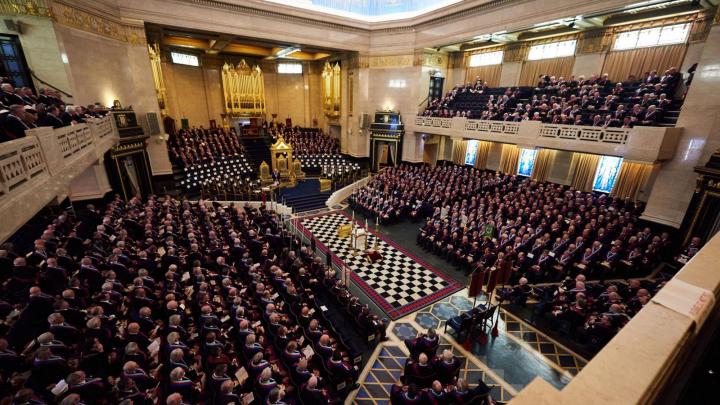
In December 2003, the United Grand Lodge of England recognised and declared the status of the Supreme Order of the Royal Arch to be "an extension of, but not a higher or lower part of, the degrees that precede it". On 10 November 2004, after deliberations by a special working party, the Supreme Grand Chapter of Royal Arch Masons of England, at its regular meeting in London, formally rejected the compromise position of 1813 and declared the Royal Arch to be a separate degree in its own right based on the completion of "pure ancient Freemasonry", consisting of the three Blue Degrees and the Royal Arch. Words in the ritual that suggested the previous compromise position and led to misinterpretations were removed by mandatory regulations. The official position of the Supreme Grand Chapter today is that the "Royal Arch is the continuation of Blue Degree Freemasonry" as taught in the three degrees of Apprentice, Companion and Master Mason; in this sense, "pure ancient Freemasonry" can be seen as a journey of self-knowledge and discovery whereby the Royal Arch completes the practical lessons of the Blue Degrees through a contemplation of the spiritual nature of man.
Building a Chapter.
Once accepted into a Chapter, the Holy Royal Arch equivalent of a Blue Degree Lodge, a candidate becomes a Companion, with Royal Arch meetings described as a convocation. The ceremony in which a Master Mason is promoted to Companion is called elevation. Holy Royal Arch Chapters are governed by three principals, who jointly rule the chapter, together in the east of the meeting.
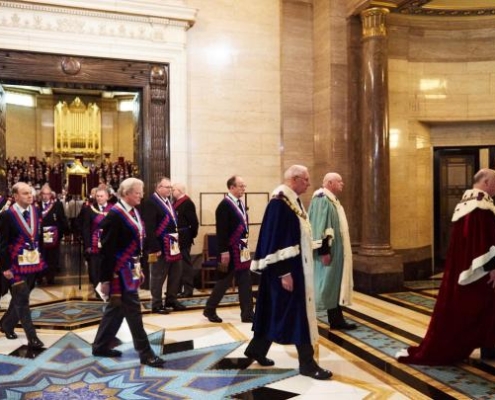
- Zerubbabel - Prince of Jerusalem
- Haggai - the Prophet
- Joshua or Jeshua - the High Priest
- Author Ezra
- Author Nehemiah
- Treasurer
- Master of Ceremonies
- 1st Resident
- 2nd Inhabitant
- 3rd Inhabitant
- Assistant Master of Ceremonies
- Kapellmeister
- Steward (there may be more than one Steward)
- Dekker
All these offices are contained in, and regulated by, the constitutions or by-laws of the various national Grand Chapters, including that of the 'mother' Grand Chapter, the Supreme Grand Chapter of England. Within the 'York Rite' version of Royal Arch Freemasonry, the Deacon may be known as the Tyler or Sentinel.
In Scotland, the Principal and Assistant Sojourners are replaced by 1st Sojourner, 2nd Sojourner and 3rd Sojourner. The 3rd Sojourner behaves a bit like the Deacon of a Blue Degree Lodge. It is common for the 3rd Princeps (Joshua) to have the Mark Lodge affiliation within the Chapter, and the 3rd Princeps (Haggai) to follow the Excellent Master Degree. Similarly, in some Scottish Chapters, the 2nd Sojourner will lead the candidate through the Excellent Master Degree, while the 1st Sojourner leads the candidate through the Royal Arch Degree. When the Mark Degree is worked in a Chapter, it is often the office bearers of the Blue Degrees Lodge, who are Royal Arch Masons, who take their usual Lodge role, as they are most used to it.
Regional level
In England and Wales, Holy Royal Arch Chapters are grouped at the regional level as either a 'Metropolitan Area' or 'Provinces' (based on the old counties), while the overseas chapters are grouped in Districts. These Metropolitan, Provincial and District Grand Chapters are governed by a 'Grand Superintendent' appointed by the 'First Grand Principal' as his personal representative for the specific area. Each Grand Superintendent is usually assisted by a deputy, and always governs together with a Second Provincial Grand Principal and a Third Provincial Grand Principal (the word 'Provincial' being replaced by the word 'Metropolitan' in a Metropolitan Area such as London, or the word 'District' in an overseas area governed from England). In many cases, the men who act as regional dignitaries in the Royal Arch will also hold the equivalent regional offices in mainstream Freemasonry.
Supreme Grand Chapter
The Supreme Grand Chapter of Royal Arch Masons of England is governed from the headquarters of the United Grand Lodge of England in Freemasons' Hall, London. The Supreme Grand Chapter is governed by three Grand Principals, who have their headquarters. The First Grand Principal is the Holy Royal Arch-equivalent of the Grand Master in the Blue Degrees. If the holder of this office is a Royal Prince, as is currently the case, he is supported by a 'Pro First Grand Principal'. As at the regional level, many officers of the Grand Lodge hold the same office in the Supreme Grand Chapter.
The legend of the Holy Royal Vault.
The Temple of Solomon existed for about four centuries until about 586 BC, when it was destroyed by a Chaldean army under King Nebuchadnezzar. The survivors from Jerusalem were forcibly deported to Babylon (the Babylonian exile), where they and their descendants remained in captivity for some 70 years. During this time Babylon was conquered by Cyrus, who became king of Persia, and, encouraged by the prophet Jeremiah, the exiled people of Jerusalem prospered. Eventually, King Cyrus issued a decree allowing the exiles to return to Jerusalem where, after a further period of delay, work finally began on rebuilding the temple on the ground where the first temple stood. This is the point at which the Royal Arch picks up the story and tells how the loss suffered by the death of the chief architect of the former Temple was made good by the restoration of that which the Master Mason recognises as lost.
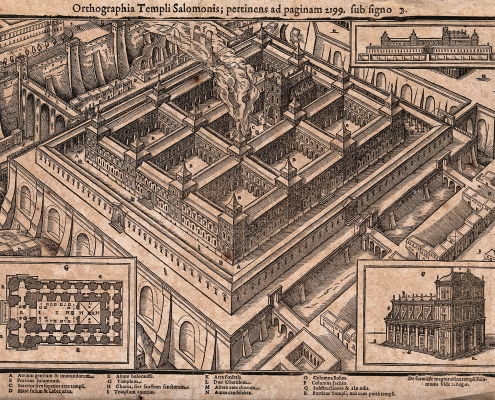
In 1659, Samuel Lee of Wadham College, Oxford published a remarkable book entitled "Orbis Miraculum", or "Solomon's Temple Depicted by Spiritual Light".
It contains references to two pillars, the ineffable Name of the Most High and other topics so familiar to Freemasons. There is also an English translation of a Greek book by Callistus, who lived in the 14th century. His work was an ecclesiastical history in which he elaborates on the earlier story of the Vault worked out by Philostorgious. This relates to Julian the Apostate's attempt to rebuild the temple around 362 AD, when a book was discovered and when opened appeared to begin with the words: "In the beginning was the Word and was with God, and the Word was God". These are the opening words of the gospel according to John. It is significant that, in the early days of Freemasonry, this chapter of the Bible was always opened in many lodges, which were consequently described as St. John's lodges or St. John's lodges.
Lee's book reveals that our legend was well known, before the 18th century, and is rich in material applicable to many other Masonic degrees besides the Royal Arch. It is therefore easy to suppose that the contents of the book might have been a guide for those who first began to formulate the Royal Arch ritual. Many learned Freemasons are inclined to think that this did indeed happen and that the basic principles of the Royal Arch spread into Lodges from this source. If this was the case, then the foundation of the Royal Arch may have been laid many years before we have any knowledge of it! Such an early reference is found in the "Book of Constitutions", written by Anderson in 1723, where he says: "The Master of a particular Lodge has the right and authority to assemble the members of his Lodge in a Chapter". This would indicate that the so-called Chapter must have performed a particular rite or ceremony, which differed from those normally performed in the lodge. If this work was related to the Royal Arch, such as something akin to "passing the veils", it must be considered part of Freemasonry, yet different from the normal degrees. Since this regulation was included by Anderson in his "Constitutions" and worded in such a way, it shows that everything that was meant by a "Chapter" was already in practice and accepted in 1723.
The Royal Arch Freemasonry today.
There is no doubt that the Royal Arch was a major factor in the negotiations between the two Blue Degrees bodies. If the Premier Grand Lodge had made any attempt to leave Royal Arch Freemasonry in an unofficial or unrecognised position, it would certainly have destroyed all hope of reconciliation. The Act of Union in 1813 "Declared and pronounced that pure old Freemasonry consists of three degrees and no more, namely: that of the Apprentice, the Companion and the Master Mason, including the Supreme Order of the Holy Royal Arch". From that date Royal Arch Freemasonry in England was no longer officially a Fourth Degree, it became an addition to or completion of the Third.
In the year following the union, representatives of the Grand Lodges of England, Ireland and Scotland met to discuss the position of the Royal Arch. It was hoped that an International Compact could be formed, but unfortunately each of the Grand Lodges went its own way.
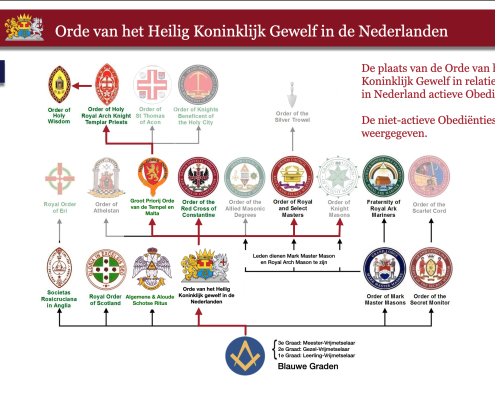
The United Grand Lodge of England has always maintained that Royal Arch Freemasonry is not a separate degree in Blue Degrees of Freemasonry. The Royal Arch is the natural development that provides a Brother with the real secrets and replaces the substitute secrets entrusted to him in his Education. As such, it is truly an integral part of English Freemasonry. However, this situation has changed. In December 2003, the United Grand Lodge decided to add the following statement to the definition of pure old Freemasonry, which since 1853 has been the preamble to the rules in the Book of Constitutions: "At its Quarterly Communication of 10 December 2003, the United Grand Lodge of England recognised and declared the status of the Supreme Order of the Holy Royal Arch as 'an extension to, but neither a superior nor a subordinate part of, the Degrees preceding it' ".
At the same time, a Ritual Committee had been set up to look at the effect of the addition to the definition on the Royal Arch ritual and to consider the rector's lectures. The Committee recommended the deletion of 27 words from the Exaltation Ceremony, the deletion of the Installed Master's qualification for the chair of the third Rector and recommended that the texts of the Rector's Lectures be revised. These were demonstrated to the Grand Chapter in November 2004 and adopted. The deletion of the 27 words and the qualification of the Installed Master became mandatory, but the new Lectures were optional, with each Chapter having the right to either stick with the old texts, adopt the new ones or use a combination of both.
Thierry Stravers is co-owner of Masonic Store.
He likes to combine his passion for style and elegance with his Masonic activities.
Thierry is the owner of Trenicaa marketing agency and is a board member of Loge Enlightenment No.313 O: Hoofddorp.

